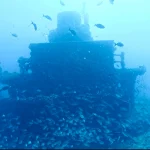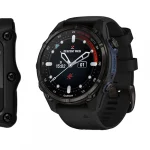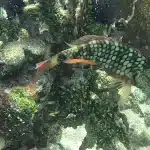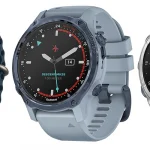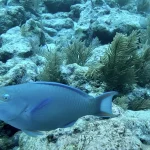Table of Contents
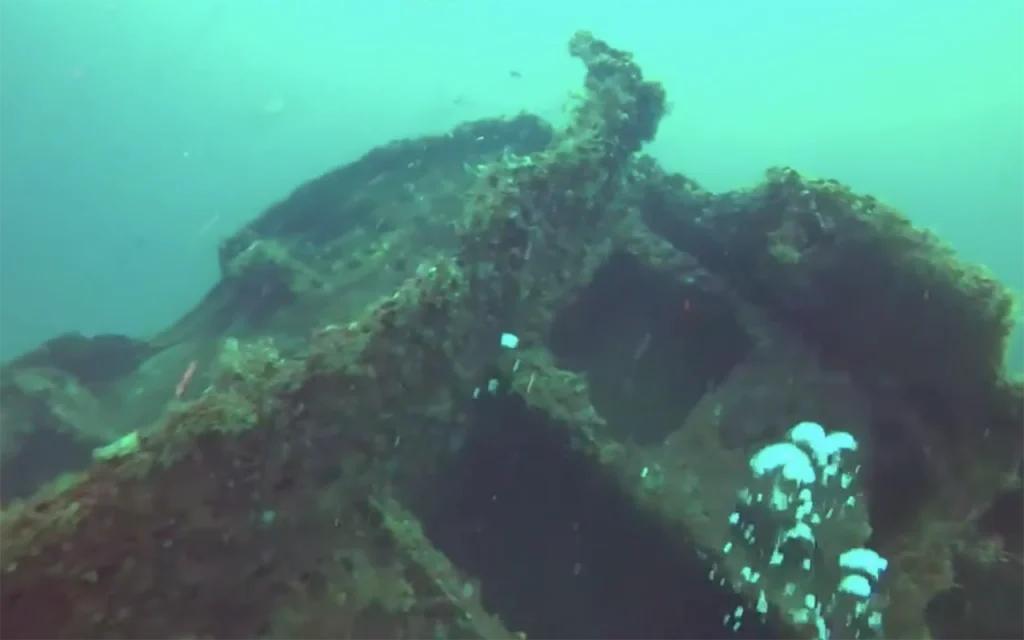
The Noulla Express is regarded as an exciting and vibrant dive site, offering both adventure and a rich underwater ecosystem.
Article at a Glance
- Historical Background: Originally built in 1939 as the Danaland, the Noulla Express has undergone several name changes and ownership transitions before being seized by the federal government in a drug case.
- Artificial Reef Creation: Intentionally sunk on July 12, 1988, off Boca Raton, Florida, the Noulla Express was designed to serve as an artificial reef, enhancing marine habitats and providing a dive site for recreational divers.
- Unique Structure: The wreck features a distinctive broken bow that tilts skyward due to damage from Hurricane Andrew, along with a twisted stern that rests on its port side, making it an intriguing site for exploration.
- Marine Biodiversity: The Noulla Express is home to a rich variety of marine life, including schools of tropical fish, barracuda, filefish, and grunts, making it a vibrant ecosystem for divers to observe.
- Nearby Dive Sites: Located within a “wreck triangle,” the Noulla Express is in close proximity to other popular wrecks, such as the United Caribbean and Sea Emperor, allowing for multi-wreck dive experiences.
- Diving Accessibility: With depths ranging from 55 to 78 feet, the Noulla Express is accessible to divers of varying skill levels, making it a popular choice for both novice and experienced divers.
- Safety Considerations: Divers are encouraged to follow safety measures, including diving with a buddy, conducting pre-dive equipment checks, and adhering to depth and safety stop protocols to ensure a safe diving experience.
Shipwreck Location Coordinates and Depth
Depth
The Noulla Express rests at the following depths:
Location Coordinates
The Noulla Express wreck is located off the coast of Boca Raton, Florida. The precise coordinates are:
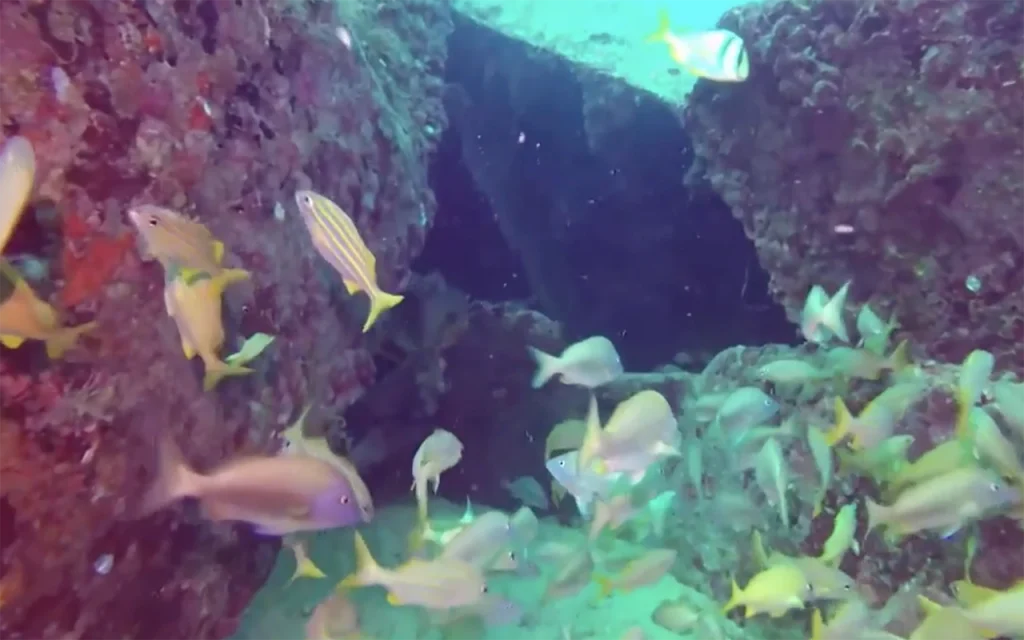
What Do Scuba Divers Say About This Ship
- Marine Life: Divers often comment on the abundant marine life around the wreck. The Noulla Express is home to a variety of tropical fish, including schools of grunts, damselfish, and bar jacks. Notably, a four-foot barracuda is frequently spotted cruising the wreck, often accompanying divers during their safety stops.
- Wreck Structure: The wreck itself presents an interesting structure for exploration. Divers appreciate the opportunity to penetrate the cargo hold, which is filled with marine life. The wreck’s bow, broken off during Hurricane Andrew, tilts skyward, adding to the visual intrigue of the dive.
- Dive Experience: Many divers enjoy starting their dive on the Noulla Express before exploring the surrounding reef. The wreck’s location near other wrecks, such as the United Caribbean and Sea Emperor, creates a “wreck triangle” that divers find appealing for multi-wreck dives.
- Adventure and Accessibility: The dive site is considered accessible for divers of various skill levels, including Open Water certified divers. The depth ranges from 60 to 90 feet, making it suitable for a range of diving experiences.
What Kind of Marine Life Can Be Found on The Ship
Fish Species
- Tropical Fish: A variety of colorful tropical fish species inhabit the wreck.
- Filefish: These are specifically mentioned as residents of the wreck.
- Barracuda: A notable presence, with a four-foot barracuda often seen cruising the wreck.
- Grunts: Large schools of grunts can be found in the cargo hold.
- Damselfish: These small, colorful fish are abundant in the wreck’s structure.
- Bar Jacks: Schools of bar jacks are frequently observed.
Other Marine Life
- Southern Stingrays: While not specifically mentioned for the Noulla Express, they are common in the area and can be found on nearby wrecks.
Ecosystem Features
- Cargo Hold: The penetrable cargo hold is described as being full of thick schools of fish, making it a highlight for divers.
- Surrounding Reef: The wreck lies near small reef patches, which likely contribute to the diversity of marine life.
Notable Observations
- A four-foot barracuda is frequently spotted and often accompanies divers during their safety stops.
- The wreck’s structure, including the broken bow and twisted hull, provides numerous hiding spots and habitats for various marine species.
Key Information
| Key Information | Details |
|---|---|
| Name | Noulla Express |
| Original Name | Danaland |
| Year Built | 1939 |
| Length | 114 feet |
| Displacement | 148 tons gross |
| Location | Off Boca Raton, Florida |
| Coordinates | Latitude: 26° 19.284′ N, Longitude: 80° 03.453′ W |
| Depth | 55-78 feet (17-24 meters) |
| Sunk | Intentionally sunk on July 12, 1988 |
| Purpose of Sinking | To create an artificial reef |
| Notable Features | Broken bow, twisted stern, cargo hold filled with fish |
| Marine Life | Tropical fish, barracuda, filefish, grunts, damselfish |
| Nearby Wrecks | United Caribbean, Sea Emperor |
| Historical Features | Winch, portholes, ladder, drug smuggler’s submarine |
| Dive Shops (Nearby) | South Florida Diving Headquarters, Pompano Dive Center, SunStar Aquatic Services |
| Safety Measures for Divers | Buddy system, pre-dive checks, safety stops, depth monitoring, dive briefings |
What Makes Noulla Express Shipwreck a Unique Diving Experience
Historical Significance
The Noulla Express has an intriguing history. Built in 1939 as the Danaland, it changed hands and names several times before being seized by the federal government in a drug case. This colorful past adds an element of intrigue to the dive.
Structural Characteristics
- Broken Bow: The bow was broken off during Hurricane Andrew and tilts skyward to the east of the main hull, creating an interesting visual feature.
- Twisted Structure: The cargo area was flattened, and the stern section is twisted 40 degrees to the east, offering a unique underwater landscape.
- Drug Smuggler’s Submarine: A small one-man submarine, once used by drug smugglers, was added to the wreckage and lies beneath the flattened cargo area, adding an unusual element to explore.
Marine Life
The wreck is home to a diverse array of marine life:
A notable four-foot barracuda is often seen cruising the wreck and frequently joins divers during their safety stops.
Diving Experience
- Penetration Opportunities: Divers can explore the cargo hold, which is filled with schools of fish.
- Multi-Wreck Dive: The Noulla Express is part of a “wreck triangle” with the United Caribbean and Sea Emperor wrecks about 300 feet to the west, allowing for a multi-wreck dive experience.
- Varied Depths: With a depth range of 55-78 feet, it’s suitable for divers of different experience levels.
Location
Situated just outside the third reef and up against a small ledge with surrounding reef patches, the Noulla Express offers divers the opportunity to explore both the wreck and the nearby reef system in a single dive.
How Does The Noulla Express Compare to Other Shipwrecks in Florida
Historical Context
Unlike many of Florida’s famous shipwrecks that date back to the colonial era or World War II, the Noulla Express is a more recent addition to Florida’s underwater landscape. It was intentionally sunk as an artificial reef, rather than being lost due to natural disasters or warfare.
Purpose
- Artificial Reef: The Noulla Express was deliberately sunk to create an artificial reef, unlike historical wrecks such as those from the 1733 Spanish fleet or WWII-era ships sunk by German U-boats.
- Dive Site: It was specifically placed to serve as a recreational dive site, whereas many other Florida wrecks were unintentional losses.
Accessibility
- Depth: At 55-78 feet deep, the Noulla Express is more accessible to recreational divers compared to some deeper historical wrecks.
- Location: It’s part of a planned “wreck triangle” with other nearby artificial reefs, making it convenient for multi-wreck dives.
Marine Life
While the Noulla Express hosts a variety of marine life, including tropical fish and barracuda, it lacks the centuries of marine growth found on older wrecks like those in the Florida Keys, which have become established ecosystems over time.
Historical Significance
- The Noulla Express doesn’t carry the same historical weight as wrecks like the Atocha or the 1733 fleet wrecks, which offer insights into colonial-era trade and maritime history.
- It doesn’t contain historical artifacts or treasure, unlike some of Florida’s more famous shipwrecks.
Structural Integrity
Being a more recent and planned sinking, the Noulla Express likely offers a more intact structure for divers to explore compared to older wrecks that have deteriorated over centuries.
What is The Full History of This Ship
Origins and Early Years
- Built in 1939 in the Netherlands by ScheepswerfT. Van Duijvendijk at Lekkerkerk
- Originally named Danaland
- Initially owned by Svend Hansen of Kragesand, Denmark
- Length: 114 feet
- Displacement: 148 tons gross
Name Changes and Ownership
- 1941: Sold and renamed Trean
- 1954: Changed hands again and renamed Kornmod (Danish for “Harvester”)
- 1968 onwards: History becomes unclear, but the vessel was rebuilt at some point
Structural Changes
- Originally had a simple wooden stern deckhouse
- Later rebuilt with a larger, raised steel structure
Final Years and Seizure
- Eventually named Noulla Express (sometimes spelled Noula Express)
- Seized by the federal government in a drug case
- Purchased by a joint committee from Palm Beach and Broward County reef programs
Sinking
- Intentionally sunk on July 12, 1988, off Boca Raton Inlet
- Purpose: To create an artificial reef
Current State
- Rests in about 75 feet of water
- Oriented roughly north-south on the seafloor
- Bow broken off during Hurricane Andrew, tilts skyward to the east of the main hull
- Stern rests on its port side
- Remainder of the ship is twisted and mangled
Additional Features
- A small one-man submarine, once used by drug smugglers, was added to the wreckage
- The submarine was found abandoned on a beach in November 1988
- Salvaged by Kellerman Diving and Salvage Company
- Sunk next to the Noulla in late September 1989
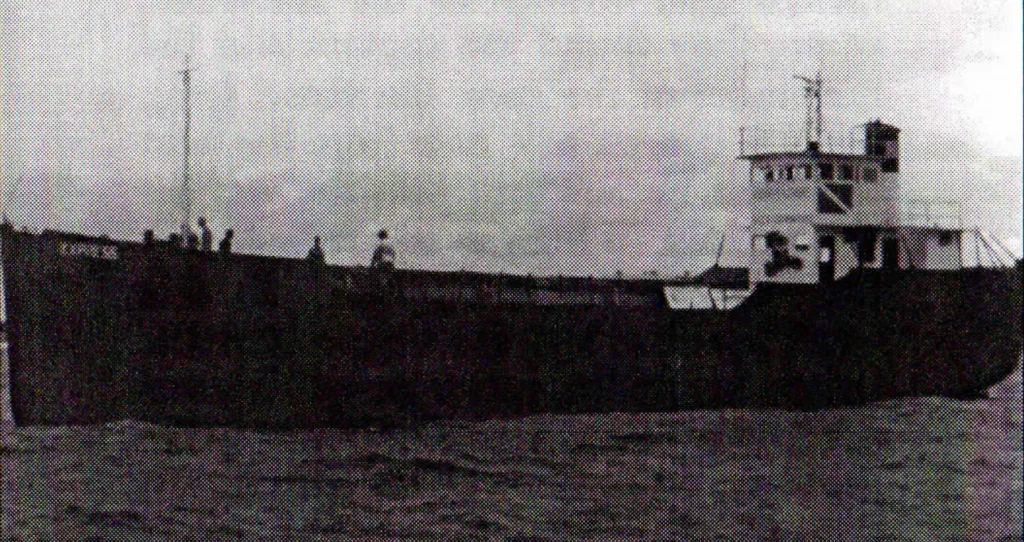
What Historical Features Can Still Be Identified on The Noulla Express Wreck
Structural Elements
- Bow Section: The bow was broken off during Hurricane Andrew and now tilts skyward to the east of the main hull, creating a distinct feature.
- Cargo Area: The cargo area was flattened, likely due to the sinking process or subsequent environmental factors.
- Stern Section: The stern rests on its port side and is twisted 40 degrees to the east, offering a unique structural element for divers to explore.
Historical Artifacts
- Winch: A winch, possibly used for anchoring or towing, can still be identified. It has capstans on either side, suggesting it might have been located near the bow.
- Portholes: Some portholes are still visible on parts of the wreckage.
- Ladder: A ladder has been observed, likely part of the ship’s original structure.
Additional Features
- Drug Smuggler’s Submarine: A small one-man submarine, once used by drug smugglers, was added to the wreckage after the initial sinking. It lies beneath the flattened cargo area, adding an unusual historical element to the site.
Marine Growth and Ecosystem
While not original to the ship, the marine life and coral growth on the wreck have become part of its current identity:
- The structure now supports various tropical fish, filefish, and barracuda.
- Small reef patches have developed around the wreck.
What Safety Measures Are in Place for Divers Visiting the Noulla Express
- Dive planning: Divers would need to plan their dive carefully, considering factors like depth, duration, and potential hazards specific to this wreck site.
- Buddy system: Diving alone is not recommended, so divers would be required to dive with a buddy or as part of a group.
- Pre-dive checks: Thorough equipment checks would be conducted before entering the water to ensure everything is in proper working condition.
- Depth monitoring: Given the wreck’s depth range of 55-78 feet, divers would need to closely monitor their depth and dive time to avoid decompression issues.
- Safety stops: A 3-5 minute safety stop at 15 feet would be recommended at the end of the dive to allow for off-gassing.
- Buoyancy control: Proper weighting and buoyancy control would be essential, especially when exploring the wreck’s structure.
- Surface marker buoys: Divers would likely be required to carry surface marker buoys (SMBs) to aid in their visibility to boats on the surface.
- Emergency equipment: Carrying emergency signaling devices like whistles or personal locator beacons (PLBs) would be advised.
- Dive briefing: A thorough briefing on the wreck’s layout, potential hazards, and emergency procedures would likely be provided before the dive.
- Fitness to dive: Divers would need to ensure they are physically fit and healthy enough for the dive, especially considering the wreck’s depth.
Dive Shops That Provide Diving Trips to This Shipwreck
- South Florida Diving Headquarters, Pompano Beach
- Pompano Dive Center
- SunStar Aquatic Services, Deerfield Beach
Central Florida Wrecks
- SS Breconshire
- Georges Valentine
- Hog Heaven
- Urca De Lima
- USS Rankin
- Ana Cecilia
- United Caribbean
- USS Mindanao
- The Laertes
- Berry Patch Tug Wreck
- The Liberty Ship
- The Ana Cecilia
- The Cities Service Empire
- USS Accokeek
- The Tortuga Wreck
- Princess Ann Wreck (Palm Beach)
- Okinawa Wreck (Pompano Beach)
- MG-111 Wreck (Jupiter)
- Lady Luck Wreck (Pompano Beach)
- Rodeo 25 Wreck (Pompano Beach)
- Lowrance Wreck (Pompano Beach)
- RSB-1 Wreck (Deerfield Beach)
- Rebel Wreck (Deerfield Beach)
- Noulla Express Wreck (Fort Lauderdale)
- Sucre Wreck (Fort Lauderdale)
- Captain Tony Wreck (Pompano Beach)
- Peter McAllister Wreck (Pompano Beach)
- Guy Harvey Wreck (Fort Lauderdale)
- Quallman Tugs Wreck (Pompano Beach)
- Miller Lite Wreck (Pompano Beach)

